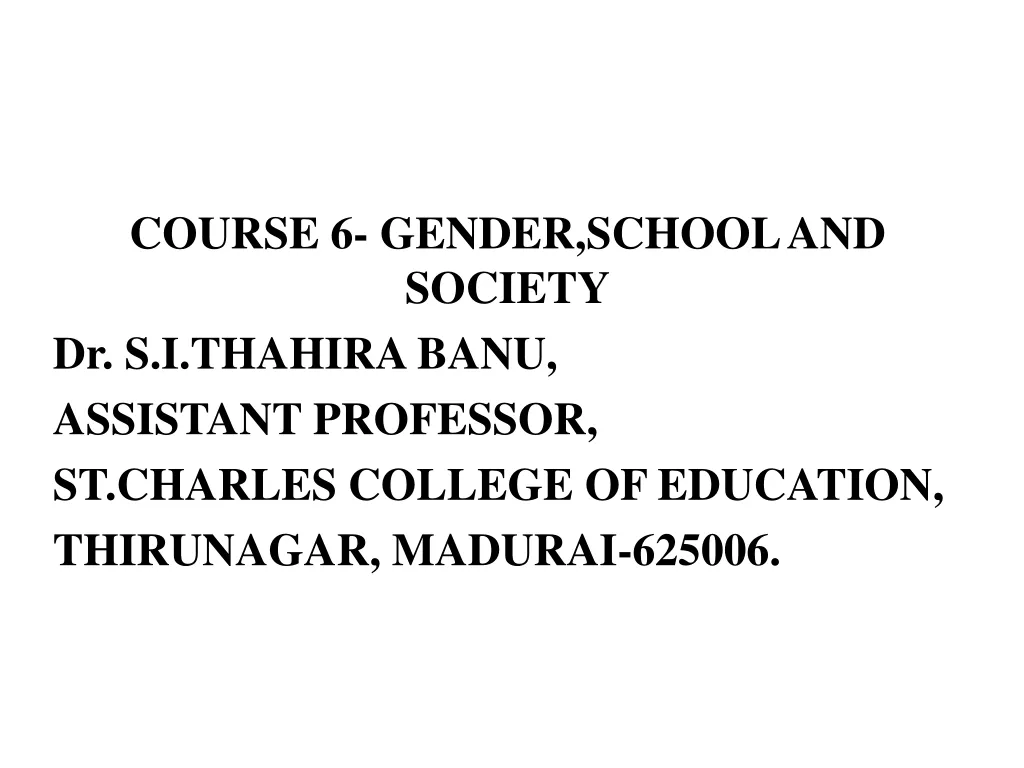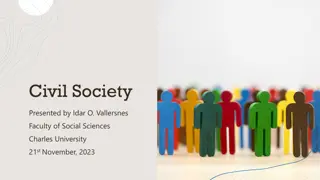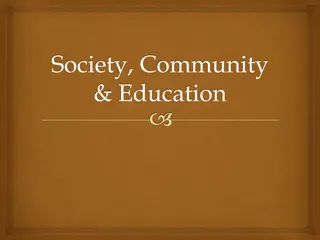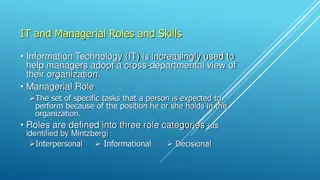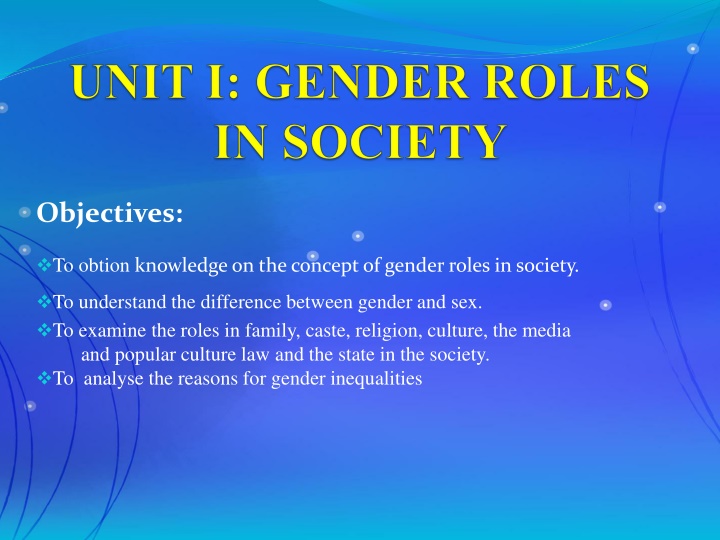
Gender Roles in Society: An Analytical Examination
Explore the concept of gender roles in society, differentiate between gender and sex, and analyze the impact of family, caste, religion, culture, law, and state on gender inequalities. Discover how societal norms and values shape gender discrimination, exploitation, and injustices.
Download Presentation

Please find below an Image/Link to download the presentation.
The content on the website is provided AS IS for your information and personal use only. It may not be sold, licensed, or shared on other websites without obtaining consent from the author. If you encounter any issues during the download, it is possible that the publisher has removed the file from their server.
You are allowed to download the files provided on this website for personal or commercial use, subject to the condition that they are used lawfully. All files are the property of their respective owners.
The content on the website is provided AS IS for your information and personal use only. It may not be sold, licensed, or shared on other websites without obtaining consent from the author.
E N D
Presentation Transcript
Objectives: To obtion knowledge on the concept of gender roles in society. To understand the difference between gender and sex. To examine the roles in family, caste, religion, culture, the media and popular culture law and the state in the society. To analyse the reasons for gender inequalities
INTRODUCTION Gender is constructed in individual, interactional, and structural ways to create environmental constraints and opportunities that usually benefit men more than women. Gender does not, however, affect families lives in isolation. And this phenomenology existing naturally which highlight the issues of gender discrimination, exploitation, inequalities and injustice in the society regulated by norms and values.
Difference between gender and sex Gender Sex Gender is socially constructed have specific roles, responsibilities and behaviour patterns. Gender is culture specific It varies within and between in society (i.e.as per regulations of social institutions) Sex is biological; it refers to noticeable differences in reproductive organs. Sex is natural, constant and Universal. Sex cannot be changed.
Gender roles in society Family: The child s first influence in regards to gender roles is the family. From birth to five years of age, most children are almost constantly surrounded by family. A child s first exposure to gender differences is learned through interaction with his or her parents. Most parents dress their infants in gender-specific clothing and give them toys according to gender stereotypes. Gender stereotypes are especially evident in the distribution of gender specific toys to children.
Gender and Caste Indian population follows a rigid caste system which divides people into a hierarchy distribution of power, status, and identity in society (Macwan, 2006). The caste system, is divided into four distinct classes comprised of (in descending order of superiority ) priests, warriors, artisans, and peasants. The objective of welfare state was to make a modern caste-less society by reducing centuries old disabilities inflicted upon the depressed and attempt to improve their lot by providing them reservations and quotas in education aswell as job market especially in state- bureaucracy and over-sized public sector enterprises. that governs the
Religion: The main religions of the world all contain certain ideas about the appropriate role for men and women in society, and traditionally. This has placed women in the home and men in the outside world. Nevertheless,data shows that Muslims and Buddhists seem to have less egalitarian gender role attitudes. than Jews, Protestants and Catholics even when other factors are controlled for, Islam in particular has been criticised for suppressing women.
Culture: Culture refers to the beliefs and practices of another society, particularly where these are seen as closely linked with tradition or religion. Culture is part of the fabric of every society. Social media: Gender roles and stereotypes have slowly started to change in society within the past few decades. These changes occur mostly in communication, but more specifically during social interactions. Mass media: Gender biases and stereotypes are amply reinforced in the mass media. In newspapers,for instance,
Popular culture: Popular culture might also be defined as a place for creating new forms of expression as well as a vehicle for critique. In particular, mainstream popular culture and media offer a space where new meanings are made through tactics such as culture jamming. Recent research by cultural historians has argued that it was the middle decades of the eighteenth century when broader notions of gender equality began to take hold across Western societies.
Law and the State: Access to justice is important for gender equality because it enables equitable enjoyment of a whole range of rights and resources. Law and justice institutions play a key role in the distribution of rights and resources among women and men across all sectors. Article 15 of the Constitution provides for prohibition of discrimination on grounds of sex also apart from other grounds such as religion, race, caste or place of birth. Article 15(3) authorizes the Sate to make any special provision for women and children.
REASONS FOR GENDER IN EQUALITIES: The root cause of gender inequality in Indian society lies in its patriarchy system. The causes of gender inequalities are complex, but a number of cultural factors in India can explain how son preference, a key driver of daughter neglect, is so prevalent. Extreme poverty and lack of education are also some of the reasons for women s low status in society.
GENDER EDUCATION OUTSIDE SCHOOL SETTINGS Children in this society learn at a very young age that there are differences between boys and girls. This idea permeates daily life and is encouraged by parents, peers, school, and the media. Little girls learn that they are supposed to like dolls and pink, while little boys learn that they are supposed to like trucks and the colour blue. Children may also form their own stereotypes based on the stereotypes they observe in the adults within their environment. Adults, whether intentionally or not, influence children in regard to gender role socialization through the family, media and school system.



